A Temporal Framework of Large Wildfire Suppression in Practice, a Qualitative Descriptive Study
Abstract
1. Introduction
2. Materials and Methods
2.1. Sources of Data
- eMap, a live incident mapping and resource tracking website (source of operational mapping information, fire history and a simple geographic information system (GIS) viewer used to corroborate information).
- FireWeb, a live incident-reporting website which is their primary source of integrated fire management information (source of Situation Reports (SitReps), Incident Shift Plans (also known as Incident Action Plans or IAPs), archived eMap data, linescans, operational maps and photographs).
- GIS and mapping data from internal DELWP databases (source of real-time aircraft tracking system (RATS) data, operational maps, mapping information and GIS spatial base layers for the State of Victoria).
2.2. Reconstructions
2.3. Classification of Stages
2.4. Classification of Tasks
3. Results
3.1. Suppression Overview
- Defensive Suppression—The fire behaviour is beyond the control capacity of the suppression resources.
- Offensive Suppression—The suppression resources are making ‘gains’ on the fire. Plans are emerging and being executed.
- Containment Achieved—In a post-hoc analysis, this is the clearest stage to delineate. A control line has been established along the entirety of the sector or division, and subsequent mop-up activities are expected to hold the fire at this perimeter.
- Mop-Up—While mop-up activities occur to some degree in stages 2–5, complete mop-up of some depth (typically a 30 m perimeter) is the focus of this stage.
- Patrol and Rehabilitation—The fire is still smouldering in the interior or in isolated hotspots on the perimeter. Perimeter mop-up is almost complete, and resources can be freed up for rehabilitation or demobilisation. The boundary between stages 4 and 5 is the fuzziest.
3.2. Characteristics of Stages and Activities
3.2.1. Stage 1—Defensive Suppression
3.2.2. Stage 2—Offensive Suppression
3.2.3. Stage 3—Containment Achieved
3.2.4. Stage 4—Mop-Up
3.2.5. Stage 5—Patrol and Rehabilitation
3.3. Resource Use by Sector and Stage
4. Discussion
- Erroneously repeated information—the entire content of a previous SitRep was often copied to form a draft of a new SitRep, at which point one or more key pieces of information was edited and updated. This resulted in verbatim information persisting in subsequent documents that may no longer be relevant or even be contradicted by the updated information.
- Delayed recording—updates in the SitReps were not always a full update of the whole fire. There was often a lag in record keeping, for example, a linescan with an accurate size and location of the fire may occur in the morning, but the size may not have been updated in the records until much later in the day.
- Planned vs. actual events—records include the plans for a day or a shift that may not have actually occurred. An indication of the completion status of planned works or whether plans were abandoned was not always provided.
- The records were rife with spelling errors, name changes, local geographic references, abbreviations, shifting geographic boundaries and jargon.
- Resource numbers and locations were not always recorded accurately—tabulated numbers may be contradicted by written descriptions, and appliances (trucks, etc.) may be listed without the crew numbers to staff them or resource numbers carried forward on records when resources were no longer present.
- Multiple wildfires may have been managed by the same IMT and records for one fire may include information for multiple events.
- Extending production rates derived from field observations [79] of one of the 20 tasks that we identified as a proxy for resource needs would lead to chronic under-resourcing because resources are required to carry out a much broader range of tasks. This is supported by the findings of Haven et al. [82] that observed production rates are overly optimistic.
- Resourcing for a fraction of the required tasks may result in the wrong bundle (type and amount) of resources because we do not understand how the resources are being used.
5. Conclusions
- Defensive: The fire behaviour is beyond the control capacity of the suppression resources. The focus is firefighter safety, asset protection and slowing the fire.
- Offensive: The suppression resources are making ‘gains’ on the fire. Plans are emerging and being executed. The largest range in fire behaviour and suppression actions occurs in this stage.
- Containment: A control line has been established along the entirety of the sector or division, and subsequent mop-up activities are expected to hold the fire at this perimeter.
- Mop-Up: While mop-up activities occur to some degree in stages 2–5, complete mop-up of some depth (typically a 30 m perimeter) is the focus of this stage.
- Patrol and Rehabilitation: The fire is still smouldering in the interior or in isolated hotspots on the perimeter. Perimeter mop-up is almost complete, and resources can be freed up for rehabilitation or demobilisation.
Author Contributions
Funding
Acknowledgments
Conflicts of Interest
Appendix A
Appendix A.1. Stonyford
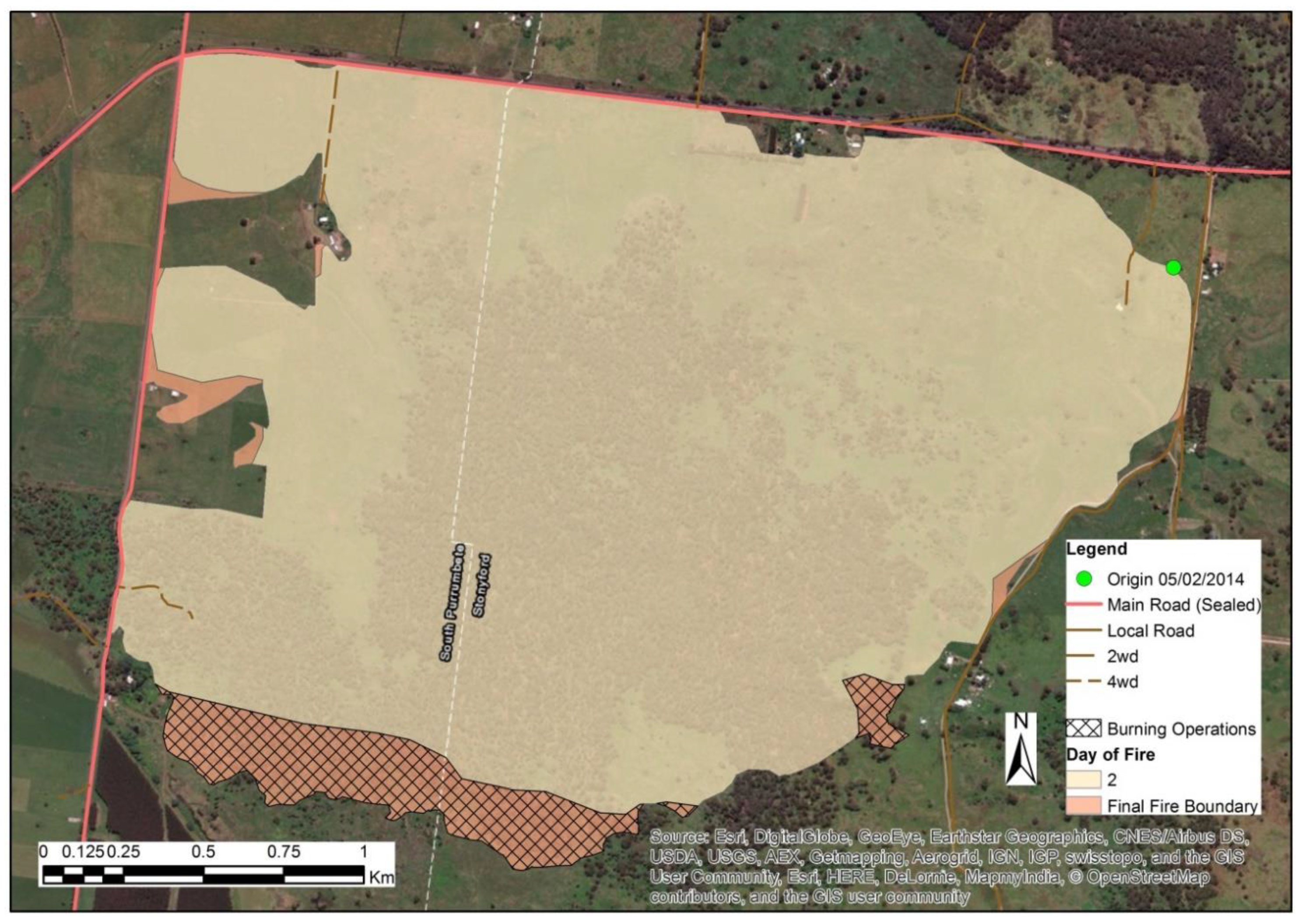
Appendix A.2. Hallston
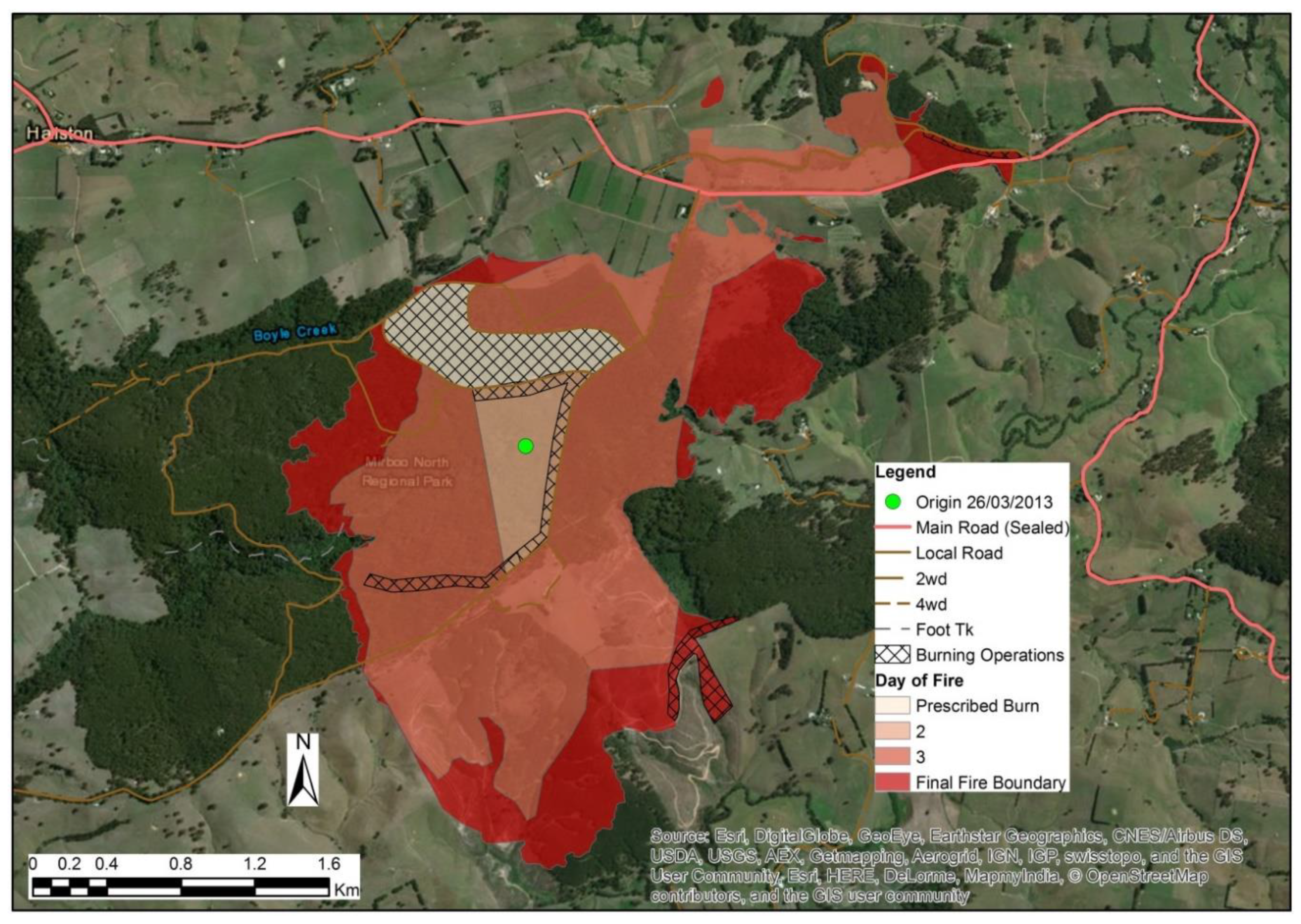
Appendix A.3. Powelltown
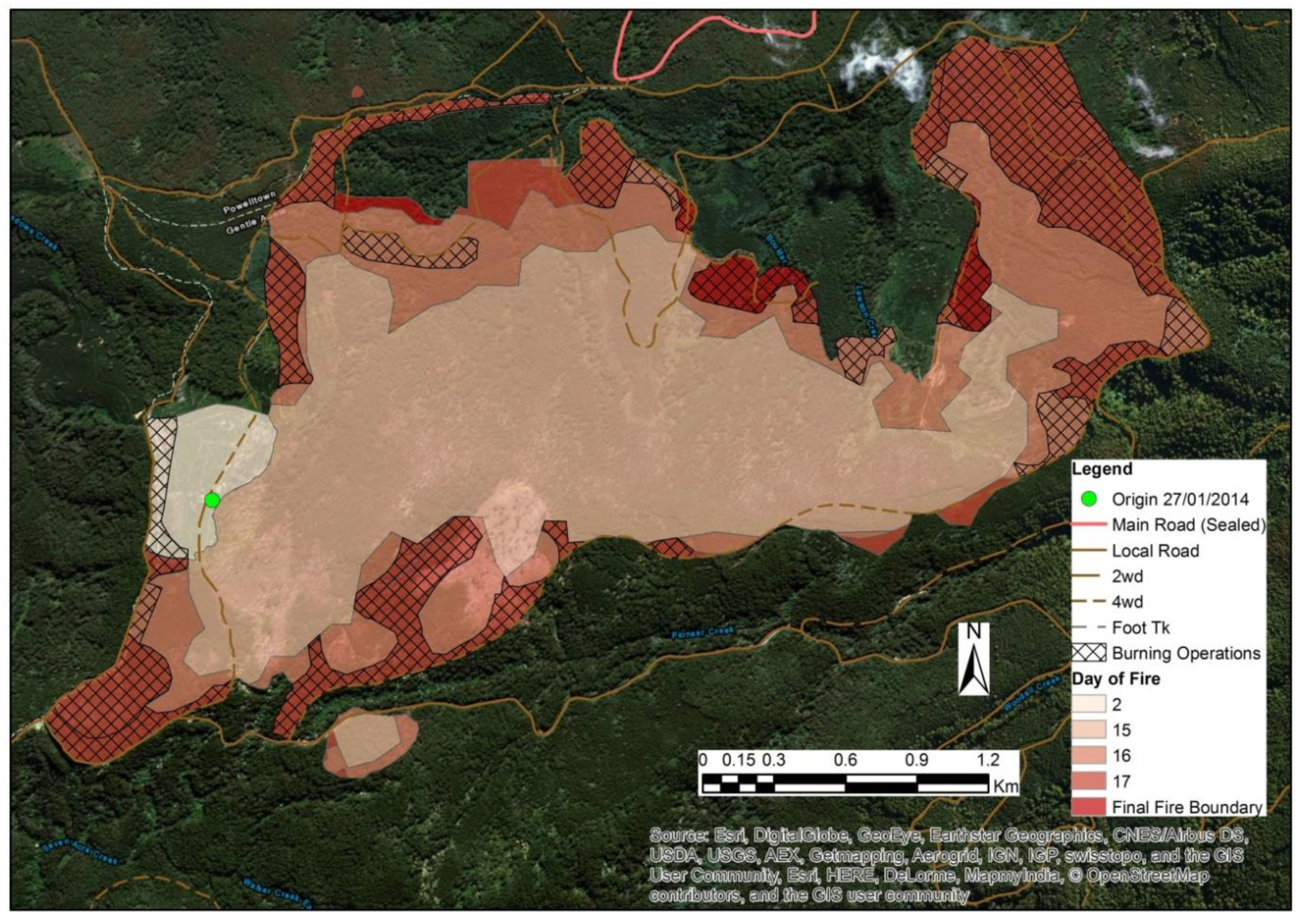
Appendix A.4. Corryong
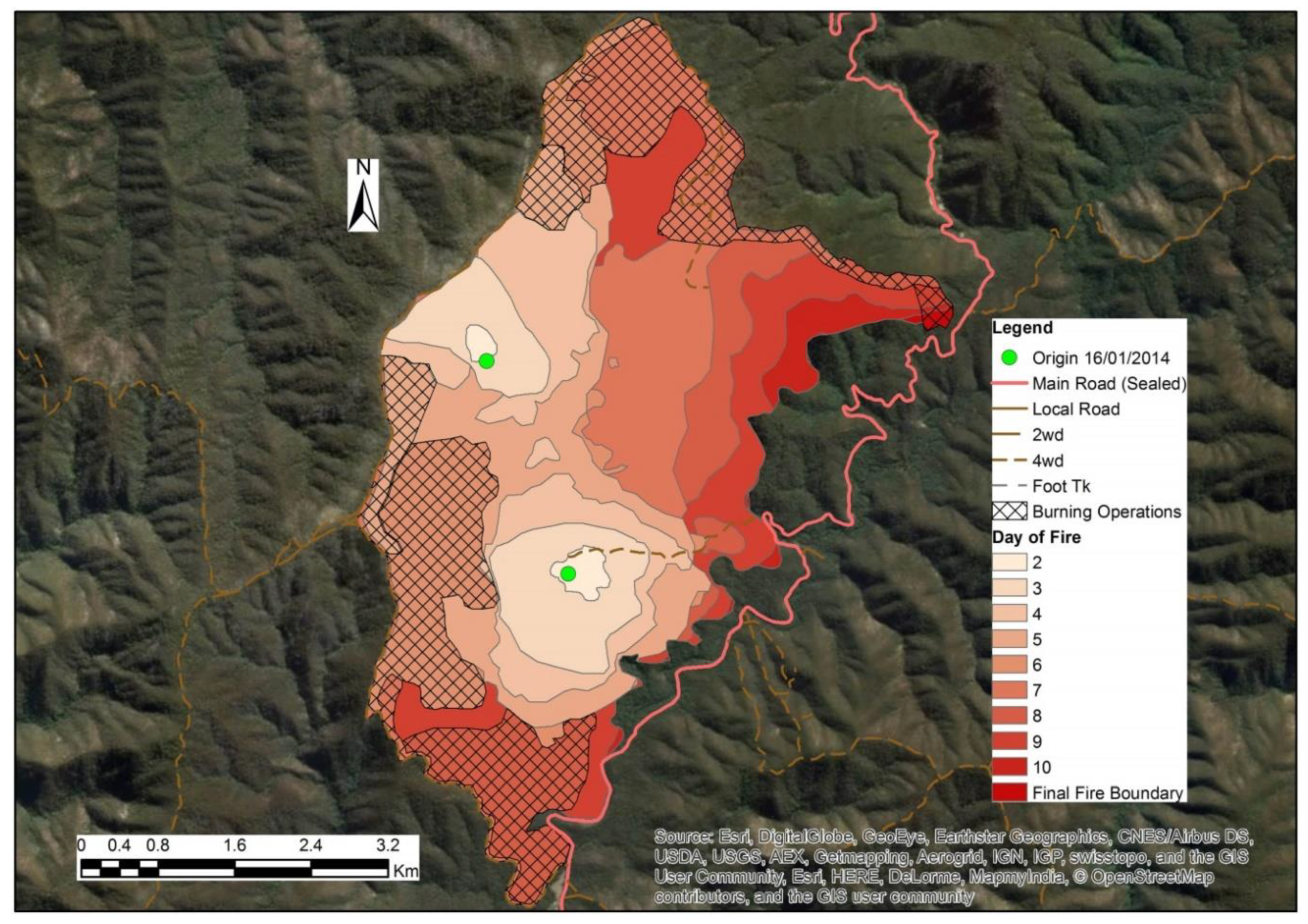
Appendix A.5. Morwell
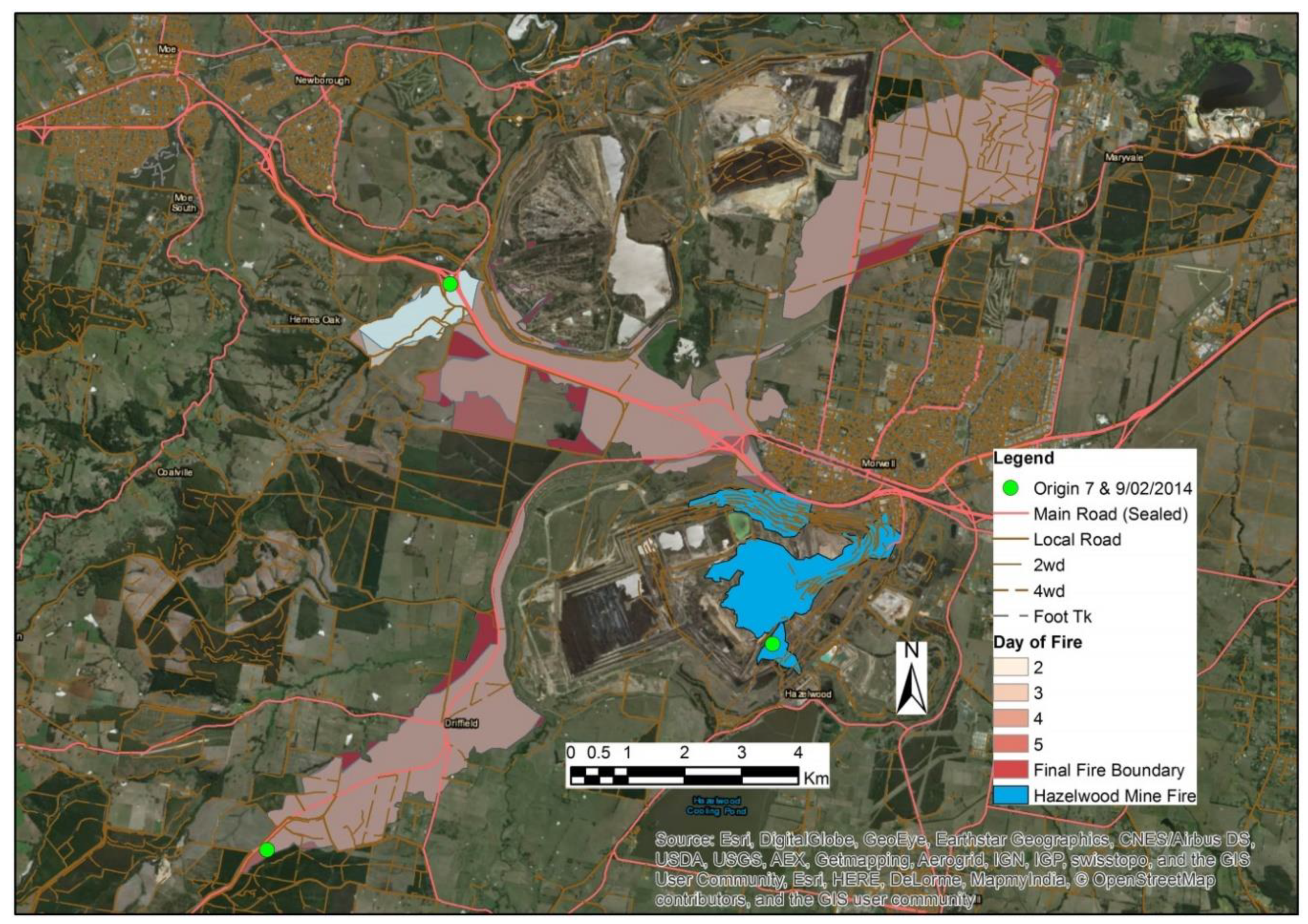
Appendix A.6. Timbarra
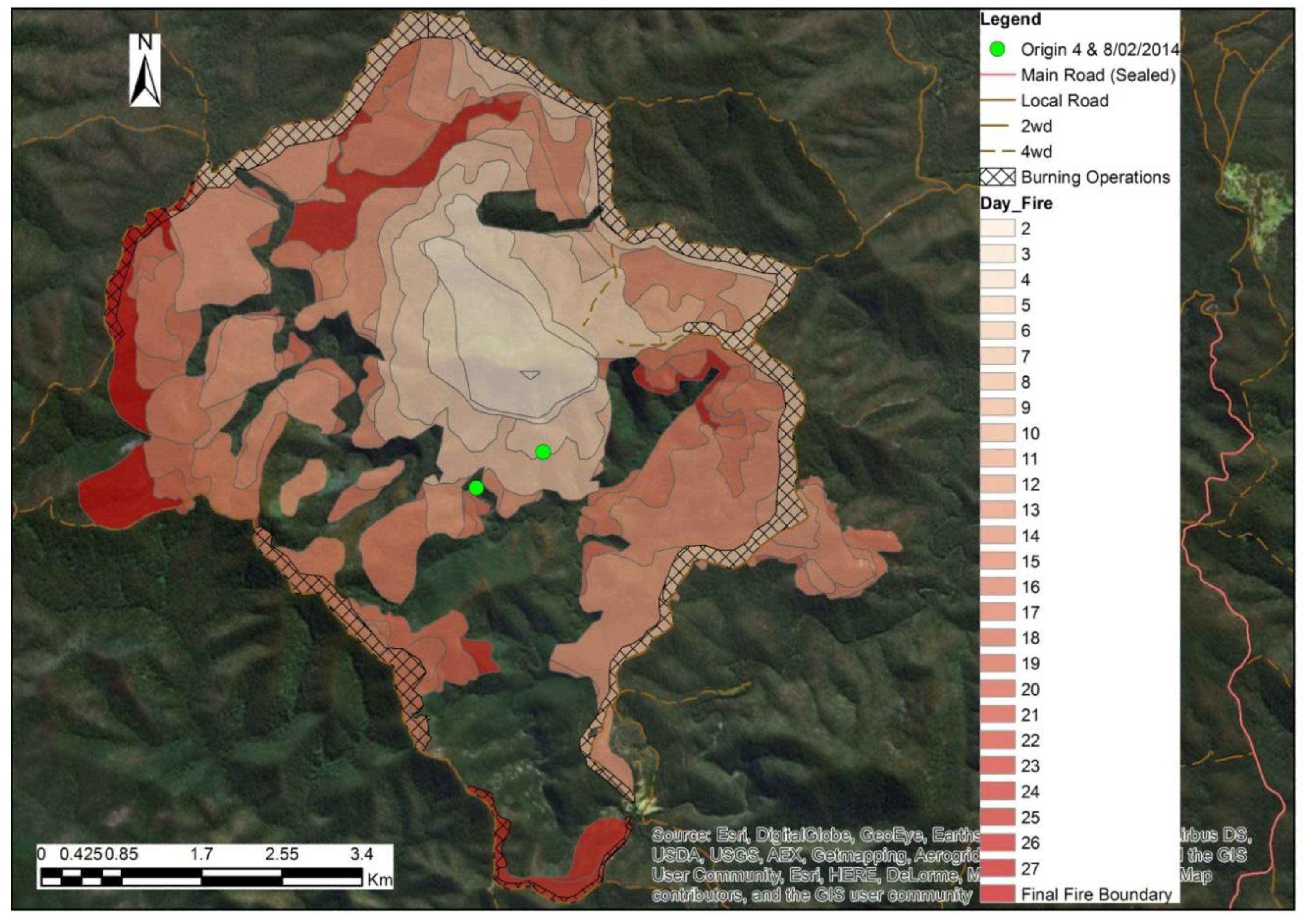
Appendix A.7. Lake Rowan
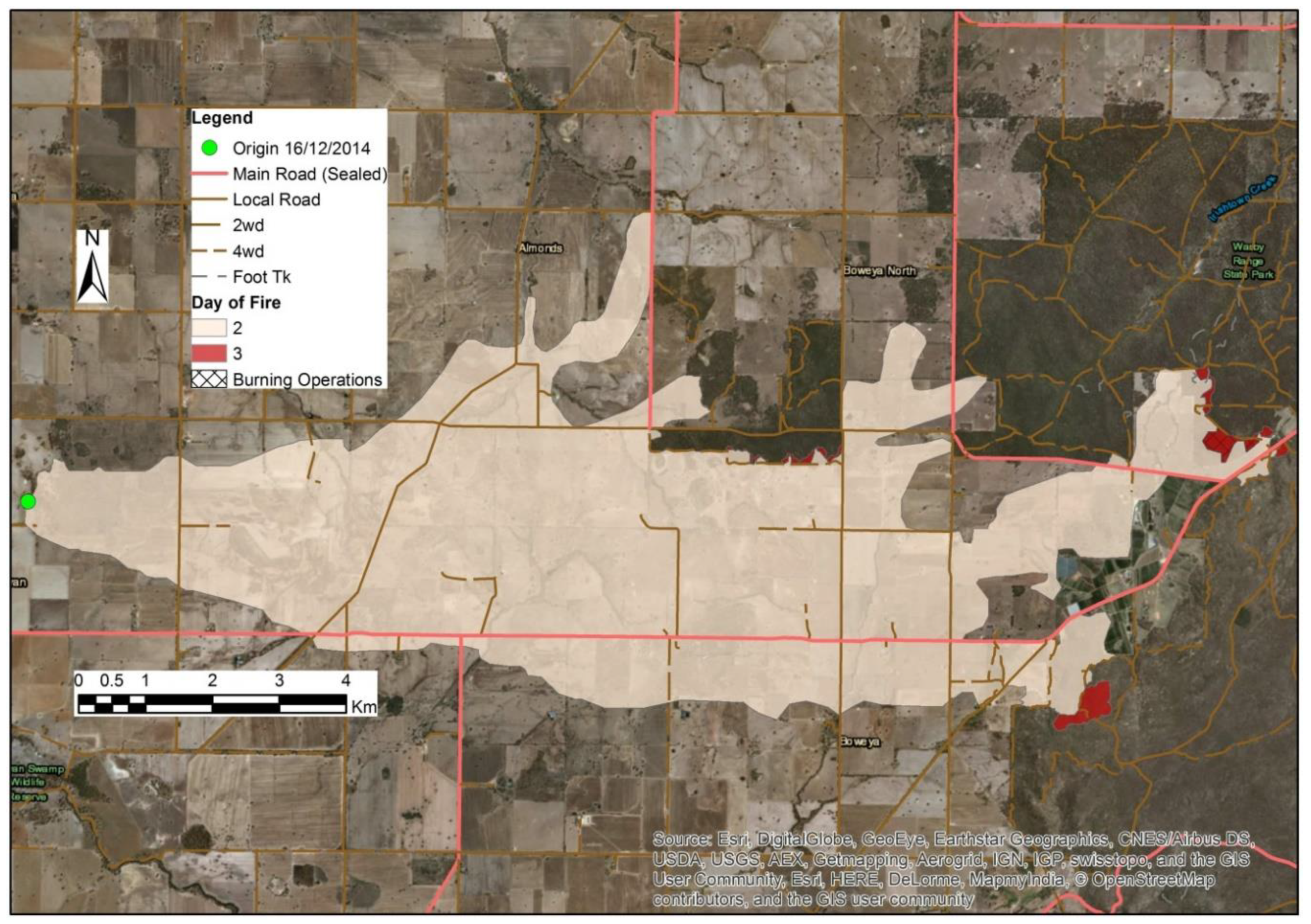
Appendix A.8. Kentbruck
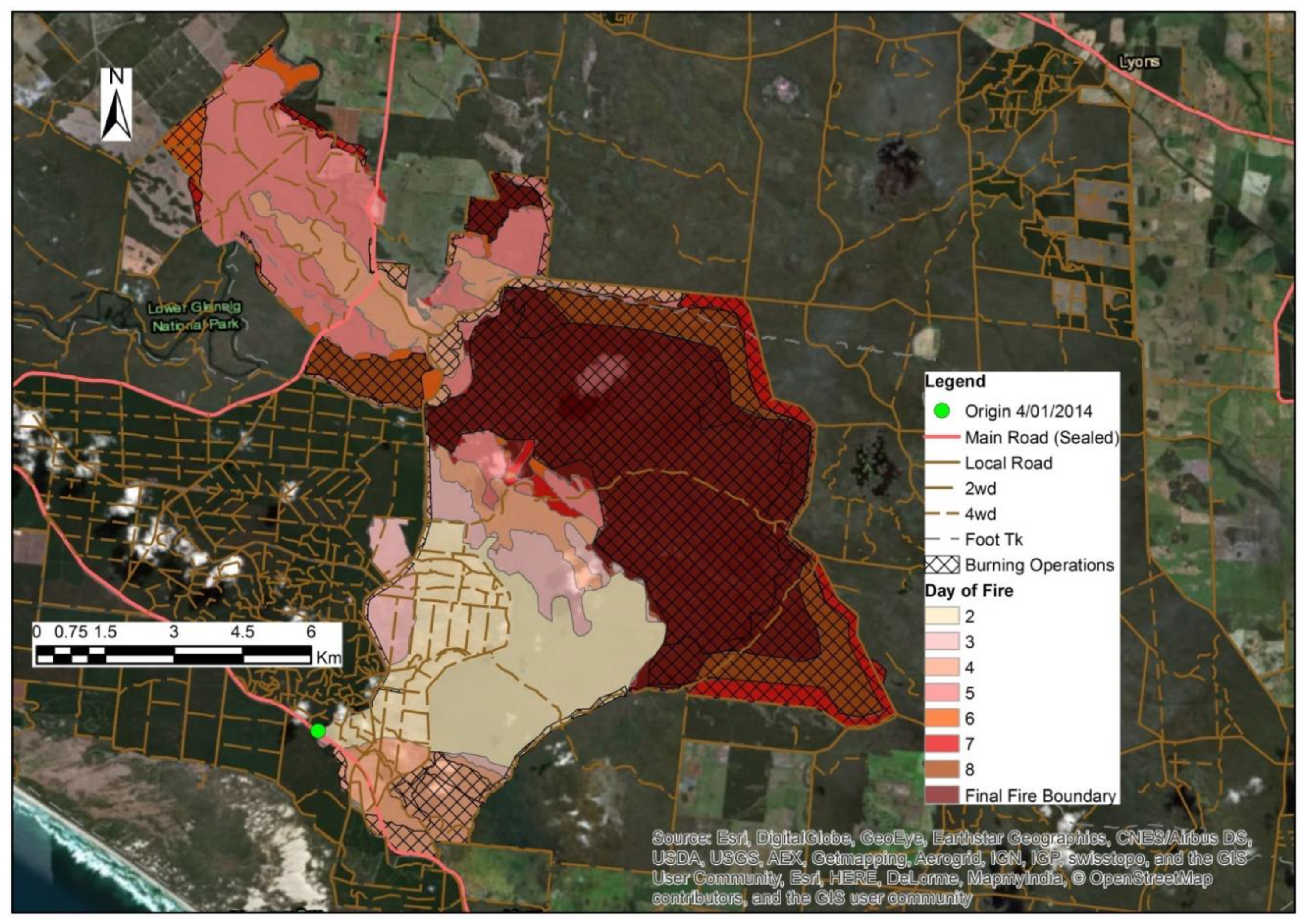
Appendix A.9. Mickleham
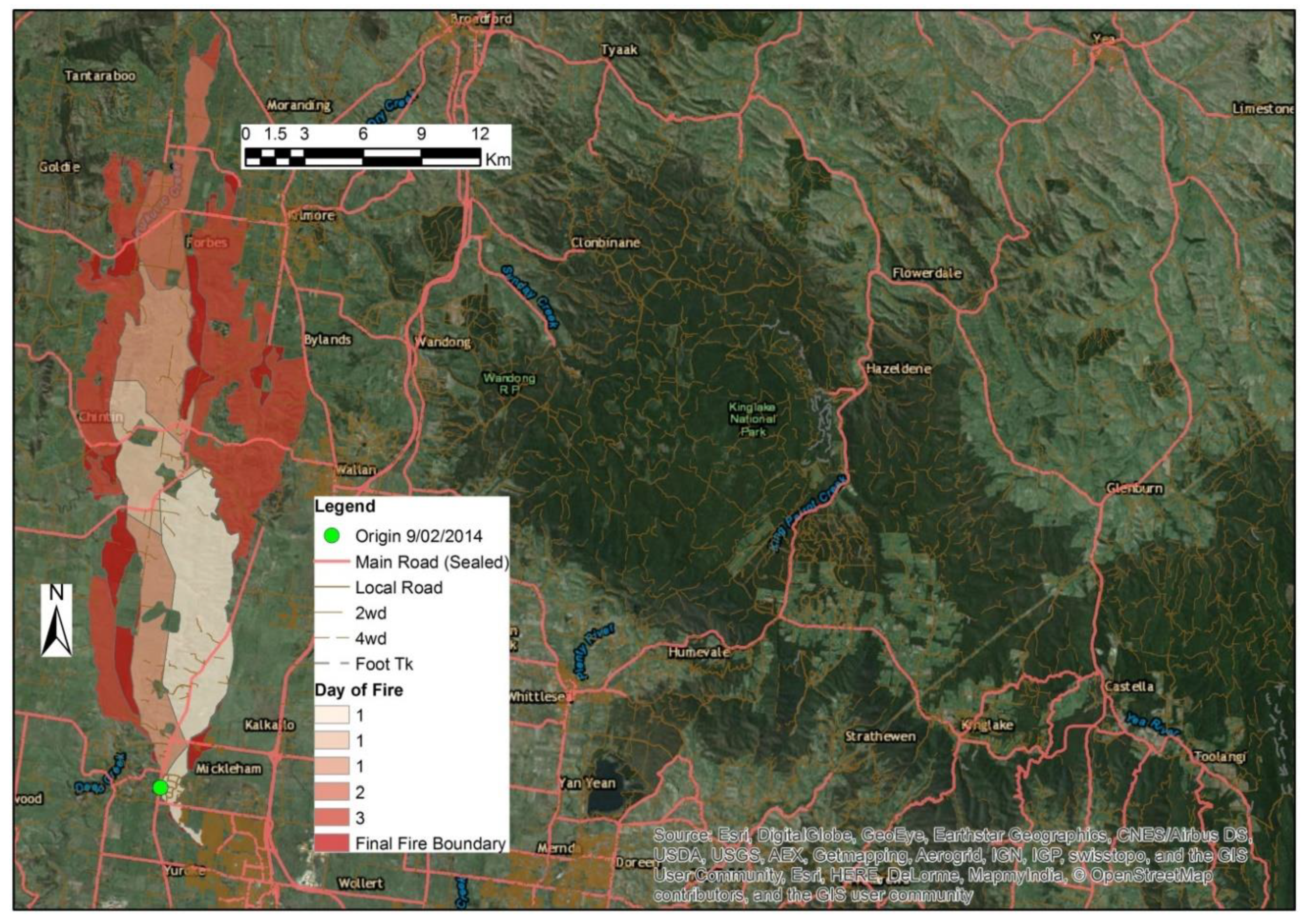
Appendix A.10. Grampians
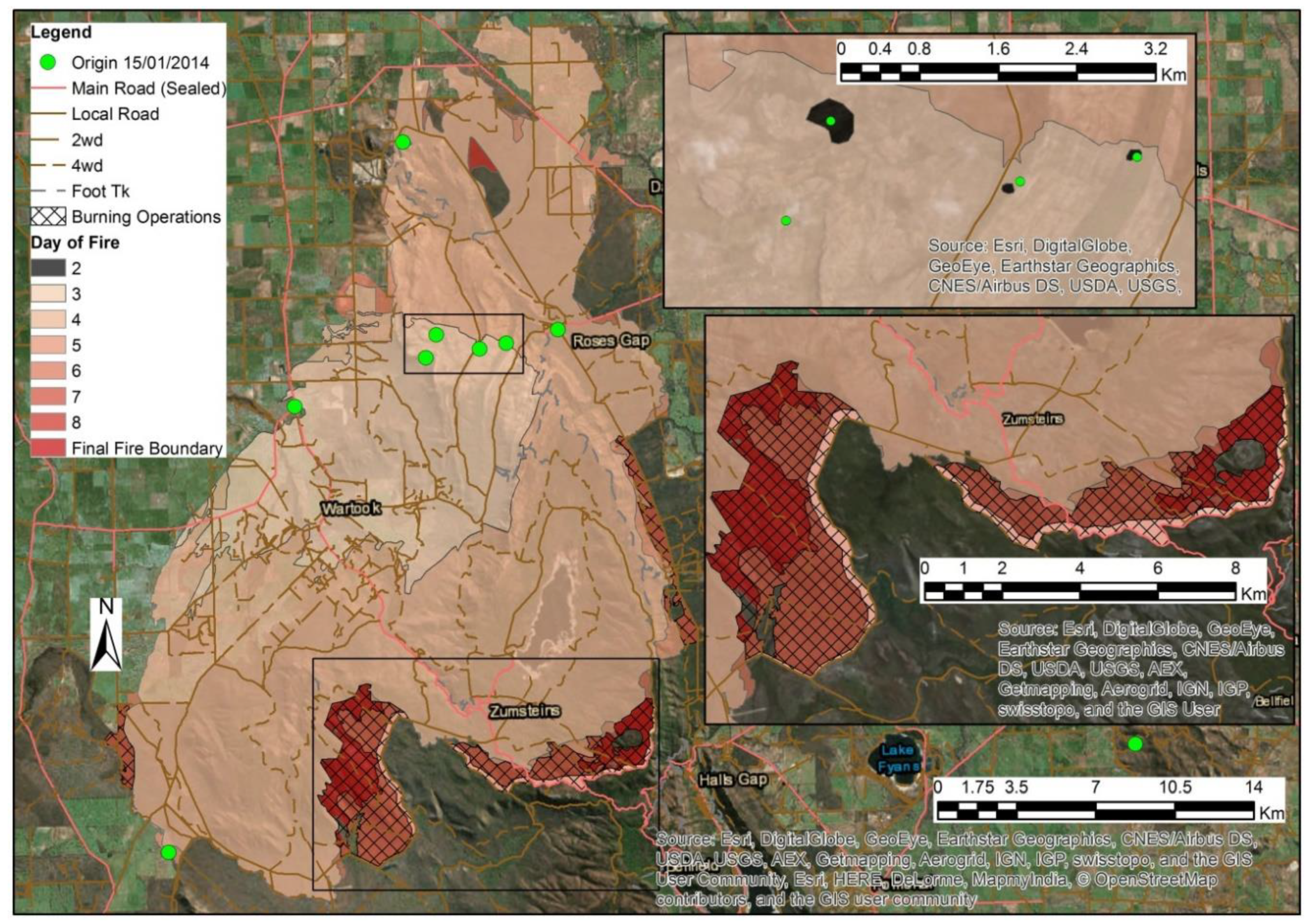
Appendix B
| Task | Description |
|---|---|
| Slow running fire | When containment or extinguishment is unlikely, aircraft drop water, foam, or chemical retardant on the head or flanks of a running wildfire to slow the forward rate of spread or decrease the head-fire width. |
| Retard potential fire behaviour | While control lines are being established aircraft drop water, foam, or chemical retardant on fuels that are burning inside, often at a distance of a km or more, of the proposed control lines of prevent fire behaviour from building into an organised flame front. Fuel at the drop locations is later burnt either naturally or during burning operations. |
| Contain spot fires | Aircraft drop water, foam, or chemical retardant on spot fires to prevent further spread and/or ground resources extinguish the spotfire, establishing control lines if necessary. |
| Establish control lines | Existing barriers (e.g., roads) provide access and a defensible, fuel free space from which the wildfire can be directly suppressed as it approaches or as a location from which burning operations can be initiated. Modification (e.g., brushing vegetation) may be necessary. Mineral earth control lines are constructed by plant/heavy equipment such as dozers/graders or ground crews either directly adjacent to the burning wildfire impeding spread or in a geographically favourable location from which burning operations can be initiated. The fire edge is fully extinguished (a wetline) and burnt fuel that will not re-burn forms the control line. Aircraft drop retardant to reinforce an alternate control line (no standalone retardant lines in case studies). |
| Knock down flare ups | Depending on accessibility, either ground crews or aircraft suppress a flare-up, or a small burst of increased fire behaviour in internal unburnt patches of fuel to prevent embers from causing spot fires. |
| Burn control lines | A fire is ignited progressively along a constructed or existing control line. The anthropogenic fire either spreads to join the wildfire or the intervening unburnt fuel is burnt in another operation. |
| Burn un-burnt patches | After the fuel along the control line has been burnt, either naturally or via anthropogenic means, interior areas of unburnt fuel are ignited under favourable burning conditions. |
| Aid repair to critical infrastructure | Limited resources (e.g., 1–2 ground crews and/or dozer) assist Utilities Crews with the process of repairing critical infrastructure. |
| Clean up | Debris, burnt material, and downed trees are cleared for safety and access. |
| Rehabilitate control lines | Constructed control lines are returned to an environmentally sound state to address erosion or access issues. Repairs to assets such as fences or lawns were included on some wildfires. |
| Directly defend structures | Aircraft drop water, foam, or chemical retardant on the fuels that are burning near structures or other assets. Ground crews extinguish fuels that are near structures or embers that may ignite structures. Some agencies train and equip firefighters for both wildland and structure fires, and for these agencies structure fires are part of wildland firefighting. |
| Prepare to defend structures | Crews are deployed to asset locations where wildfire impact is anticipated—though no impact is occurring. Defensive control lines are constructed, and properties are prepared for possible wildfire impact. |
| ID contingency control lines | Determine where contingency lines could be established—limited to existing features in defensive stage. |
| Construct contingency control lines | Control lines are constructed, or existing features are improved in advance of potential fire spread so as to provide a defensible space or permit future burning operations should the wildfire spread beyond current containment control lines. |
| Suppress and mop-up active fire | Suppress flaming and smouldering fuels near the wildfire edge or fire perimeter, around assets and along public roadways. |
| ID and clear hazard trees | Identify and clear hazard trees; hand falling and/or plant/heavy equipment used. |
| Full perimeter mop-up to depth | Full extinguishment of all smouldering material for a full depth (typically 30 m or greater) around the perimeter of the wildfire. |
| ID hotspots with IR | Infrared cameras (handheld or aerial) used to identify hotspots smouldering within the fully extinguished perimeter, GPS locations of hotspots marked and disseminated to ground crews to extinguish. |
| Mop-up limited hotspots | Smouldering hotspots, limited in number, discovered while patrolling the perimeter or identified by IR technology are fully extinguished. |
| Look for flare-ups and hotspots | Ground crews transit the fire perimeter to seek and supress overlooked hotspots near the fire perimeter or internal flare-ups that throw embers beyond the control lines and create spotfires. |
Appendix C
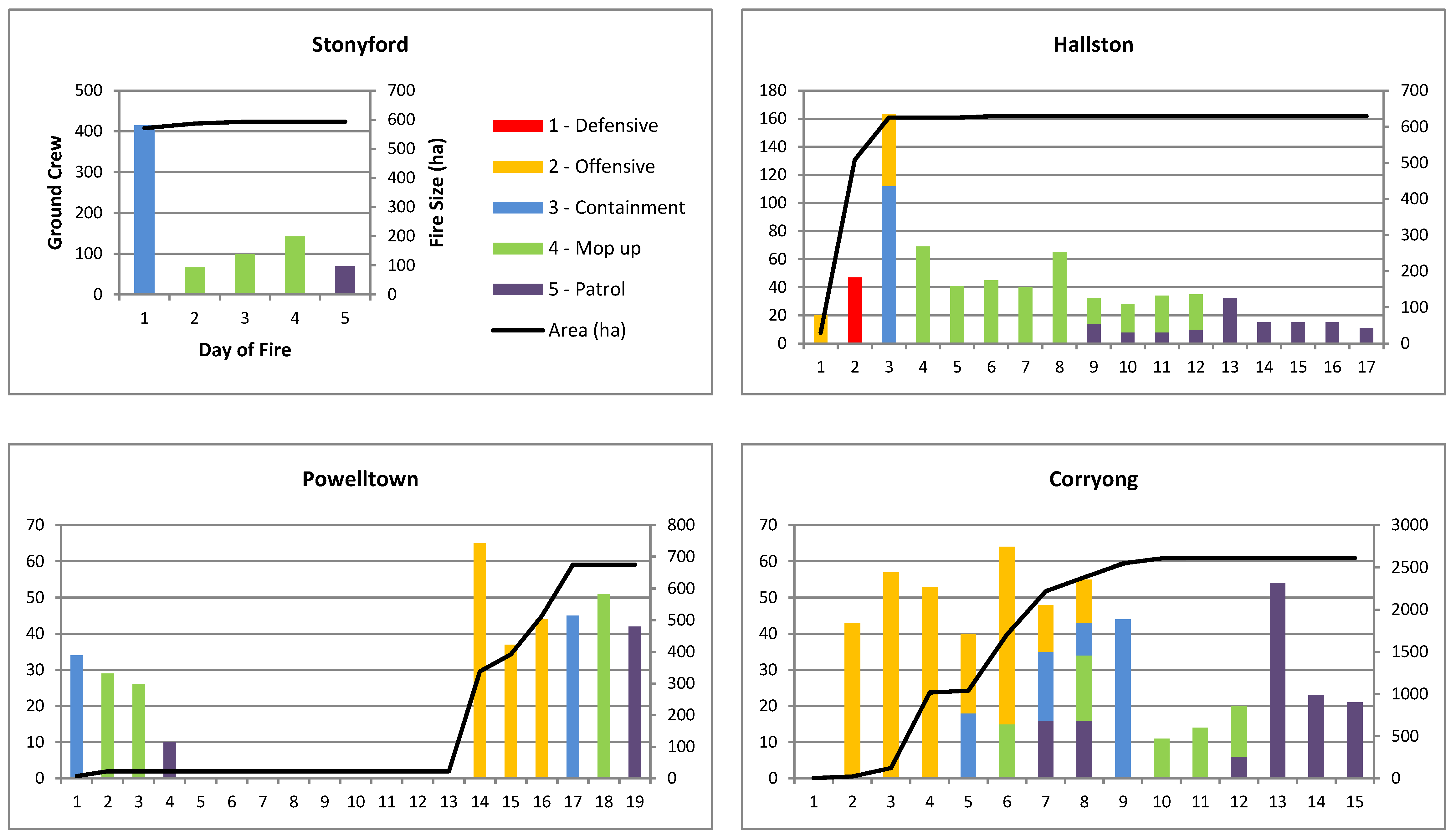


References
- Krawchuk, M.A.; Moritz, M.A.; Parisien, M.-A.; Van Dorn, J.; Hayhoe, K. Global Pyrogeography: The Current and Future Distribution of Wildfire. PLoS ONE 2009, 4, e5102. [Google Scholar] [CrossRef] [PubMed]
- Strauss, D.; Bednar, L.; Mees, R. Do One Percent of the Forest Fires Cause Ninety-Nine Percent of the Damage? For. Sci. 1989, 35, 319–328. [Google Scholar]
- Stocks, B.J.; Mason, J.A.; Todd, J.B.; Bosch, E.M.; Wotton, B.M.; Amiro, B.D.; Flannigan, M.D.; Hirsch, K.G.; Logan, K.A.; Martell, D.L.; et al. Large forest fires in Canada, 1959–1997. J. Geophys. Res. 2002, 107, 8149. [Google Scholar] [CrossRef]
- Donovan, G.H.; Brown, T.C. An Alternative Incentive Structure for Wildfire Management on National Forest Land. For. Sci. 2005, 51, 387–395. [Google Scholar]
- Omi, P.N. Forest Fires: A Reference Handbook; ABC-CLIO: Santa Barbara, CA, USA, 2005; ISBN 978-1-85109-438-7. [Google Scholar]
- San-Miguel-Ayanz, J.; Moreno, J.M.; Camia, A. Analysis of large fires in European Mediterranean landscapes: Lessons learned and perspectives. For. Ecol. Manag. 2013, 294, 11–22. [Google Scholar] [CrossRef]
- Mell, W.E.; Manzello, S.L.; Maranghides, A.; Butry, D.; Rehm, R.G. The wildland–urban interface fire problem – current approaches and research needs. Int. J. Wildland Fire 2010, 19, 238. [Google Scholar] [CrossRef]
- Moritz, M.A.; Batllori, E.; Bradstock, R.A.; Gill, A.M.; Handmer, J.; Hessburg, P.F.; Leonard, J.; McCaffrey, S.; Odion, D.C.; Schoennagel, T.; et al. Learning to coexist with wildfire. Nature 2014, 515, 58–66. [Google Scholar] [CrossRef]
- Fernandes, P.M. Fire-smart management of forest landscapes in the Mediterranean basin under global change. Landsc. Urban Plan 2013, 110, 175–182. [Google Scholar] [CrossRef]
- Thompson, M.P.; Haas, J.R.; Finney, M.A.; Calkin, D.E.; Hand, M.S.; Browne, M.J.; Halek, M.; Short, K.C.; Grenfell, I.C. Development and application of a probabilistic method for wildfire suppression cost modeling. For. Policy Econ. 2015, 50, 249–258. [Google Scholar] [CrossRef]
- U.S. Government Accountability Office. Wildland Fire Management: Lack of Clear Goals or a Strategy Hinders Federal Agencies’ Efforts to Contain the Costs of Fighting Fires; United States Government Accountability Office: Washington, DC, USA, 2007. [Google Scholar]
- NSW Rural Fire Service. NSW RFS Annual Report 2016-17; NSW Rural Fire Service: New South Wales, Australia, 2017.
- Ellis, S.; Kanowski, P.; Whelan, R. National Inquiry on Bushfire Mitigation and Management; Council of Australian Governments: Canberra, Australia, 2004.
- Holmes, T.P.; Huggett, R.J.; Westerling, A.L. Statistical Analysis of Large Wildfires. In The Economics of Forest Disturbances; Holmes, T.P., Prestemon, J.P., Abt, K.L., Eds.; Forestry Sciences; Springer: Amsterdam, The Netherlands, 2008; pp. 59–77. ISBN 978-1-4020-4369-7. [Google Scholar]
- Finney, M.; Grenfell, I.C.; McHugh, C.W. Modeling Containment of Large Wildfires Using Generalized Linear Mixed-Model Analysis. For. Sci. 2009, 55, 249–255. [Google Scholar]
- Katuwal, H.; Dunn, C.; Calkin, D.E. Characterising Resource Use and Potential Inefficiencies during Large-Fire Suppression in the Western US. Int. J. Wildland Fire 2017, 26, 604–614. [Google Scholar] [CrossRef]
- Plucinski, M.P. Fighting Flames and Forging Firelines: Wildfire Suppression Effectiveness at the Fire Edge. Curr. For. Rep. 2019, 5, 1–19. [Google Scholar] [CrossRef]
- Plucinski, M.P. Contain and Control: Wildfire Suppression Effectiveness at Incidents and Across Landscapes. Curr. For. Rep. 2019, 5, 20–40. [Google Scholar] [CrossRef]
- Duff, T.J.; Tolhurst, K.G. Operational wildfire suppression modelling: A review evaluating development, state of the art and future directions. Int. J. Wildland Fire 2015, 24, 735–748. [Google Scholar] [CrossRef]
- Katuwal, H.; Calkin, D.E.; Hand, M.S. Production and efficiency of large wildland fire suppression effort: A stochastic frontier analysis. J. Environ. Manag. 2016, 166, 227–236. [Google Scholar] [CrossRef]
- Stonesifer, C.S.; Calkin, D.E.; Thompson, M.P.; Stockmann, K.D. Fighting fire in the heat of the day: An analysis of operational and environmental conditions of use for large airtankers in United States fire suppression. Int. J. Wildland Fire 2016, 25, 520–533. [Google Scholar] [CrossRef]
- Thompson, M.P.; y Silva, F.R.; Calkin, D.E.; Hand, M.S. A review of challenges to determining and demonstrating efficiency of large fire management. Int. J. Wildland Fire 2017, 26, 562–573. [Google Scholar] [CrossRef]
- Hand, M.; Katuwal, H.; Calkin, D.E.; Thompson, M.P. The influence of incident management teams on the deployment of wildfire suppression resources. Int. J. Wildland Fire 2017, 26, 615–629. [Google Scholar] [CrossRef]
- Calkin, D.E.; Stonesifer, C.S.; Thompson, M.P.; McHugh, C.W. Large airtanker use and outcomes in suppressing wildland fires in the United States. Int. J. Wildland Fire 2014, 23, 259–271. [Google Scholar] [CrossRef]
- Plucinski, M.P.; McCarthy, G.J.; Hollis, J.J.; Gould, J.S. The effect of aerial suppression on the containment time of Australian wildfires estimated by fire management personnel. Int. J. Wildland Fire 2012, 21, 219–229. [Google Scholar] [CrossRef]
- Holmes, T.P.; Calkin, D.E. Econometric analysis of fire suppression production functions for large wildland fires. Int. J. Wildland Fire 2013, 22, 246–255. [Google Scholar] [CrossRef]
- Bearman, C.; Grunwald, J.A.; Brooks, B.P.; Owen, C. Breakdowns in coordinated decision making at and above the incident management team level: An analysis of three large scale Australian wildfires. Appl. Ergon. 2015, 47, 16–25. [Google Scholar] [CrossRef] [PubMed]
- Sandelowski, M. Whatever happened to qualitative description? Res. Nurs. Health 2000, 23, 334–340. [Google Scholar] [CrossRef]
- Australasian Fire and Emergency Service Authorities Council. AFAC Bushfire Glossary. Available online: http://www.fireandbiodiversity.org.au/_literature_196883/AFAC_Bushfire_Glossary (accessed on 8 August 2019).
- Mees, R.; Strauss, D. Allocating Resources to Large Wildland Fires: A Model with Stochastic Production Rates. For. Sci. 1992, 38, 842–853. [Google Scholar]
- BC Wildfire Service Response Types and Stages of Control. Available online: https://www2.gov.bc.ca/gov/content/safety/wildfire-status/about-bcws/wildfire-response/response-terminology (accessed on 9 July 2019).
- Tasmania Fire Service Tasmania Fire Service. Available online: http://www.fire.tas.gov.au/Show?pageId=colCurrentBushfires&inverse=false&sort=STATUS&filter=ALL (accessed on 3 July 2019).
- New South Wales Rural Fire Service Fires near Me. Available online: https://www.rfs.nsw.gov.au/fire-information/fires-near-me (accessed on 9 July 2019).
- Queensland Fire and Emergency Services Current Bushfires. Available online: https://www.ruralfire.qld.gov.au:443/map/Pages/default.aspx (accessed on 3 July 2019).
- National Parks and Wildlife Service. Fire Management Manual, 2014th–2015th ed.; Office of Environment and Heritage NSW: Sydney South, Australia, 2014.
- Department of Environment, Land, Water and Planning. Bushfire Management Manual: 5. Response; Department of Environment, Land, Water and Planning: Victoria, Australia, 2015.
- Canadian Interagency Forest Fire Centre. Canadian Wildland Fire Management Glossary; Canadian Interagency Forest Fire Centre: Winnipeg, MB, Canada, 2017. [Google Scholar]
- Morse, J.M.; Mitcham, C. Exploring Qualitatively-Derived Concepts: Inductive—Deductive Pitfalls. Int. J. Qual. Meth. 2002, 1, 28–35. [Google Scholar] [CrossRef]
- Hsieh, H.-F.; Shannon, S.E. Three Approaches to Qualitative Content Analysis. Qual. Health Res. 2005, 15, 1277–1288. [Google Scholar] [CrossRef]
- Saldaña, J. The Coding Manual for Qualitative Researchers, 2nd ed.; SAGE: Los Angeles, CA, USA, 2013; ISBN 978-1-4462-4736-5. [Google Scholar]
- Krippendorff, K. Content Analysis: An Introduction to Its Methodology, 2nd ed.; Sage Publications, Inc.: Thousand Oaks, CA, USA, 2004; ISBN 0-7619-1544-3. [Google Scholar]
- Gale, N.K.; Heath, G.; Cameron, E.; Rashid, S.; Redwood, S. Using the framework method for the analysis of qualitative data in multi-disciplinary health research. BMC Med. Res. Methodol. 2013, 13, 117. [Google Scholar] [CrossRef]
- Department of Environment, Land, Water, and Planning. Bushfire Management Manual: 4. Response; Department of Environment, Land, Water and Planning: Victoria, Australia, 2016.
- DELWP Grampians_Northern_Complex_20140116_1025_SitRep_3 2014 Unpublished internal document.
- DELWP Timbarra_GilGroggin_20140208_1604_SitRep_3 2014 Unpublished internal document.
- DELWP Mickleham_Kilmore_20140209_1558_SitRep_2 2014 Unpublished internal document.
- DELWP Corryong_Kings_Creek_20140121_1808_SitRep_25 2014 Unpublished internal document.
- DELWP Corryong_Kings_Creek_20140121_2359_SitRep_26 2014 Unpublished internal document.
- DELWP Kentbruck_Portland_Nelson_Rd_20130105_Day_IAP_2 2013 Unpublished internal document.
- DELWP Lake_Rowan_Warbys_20141217_Night_IAP_4 2014 Unpublished internal document.
- DELWP Morwell_Hernes_Oak_20140210_1415_SitRep_10 2014 Unpublished internal document.
- DELWP Corryong_Kings_Creek_20140120_Day_IAP_7 2014 Unpublished internal document.
- DELWP Grampians_Northern_Complex_20140119_1439_SitRep_15 2014 Unpublished internal document.
- DELWP Kentbruck_Portland_Nelson_Rd_20130107_Day_IAP_6 2013 Unpublished internal document.
- DELWP Timbarra_GilGroggin_20140216_1104_SitRep_17 2014 Unpublished internal document.
- DELWP Timbarra_GilGroggin_20140211_1351_SitRep_8 2014 Unpublished internal document.
- DELWP Timbarra_GilGroggin_20140220_1844_SitRep_27 2014 Unpublished internal document.
- DELWP Morwell_Hernes_Oak_20140208_1126_SitRep_2 2014 Unpublished internal document.
- DELWP Lake_Rowan_Warbys_20141218_Night_IAP_6 2014 Unpublished internal document.
- DELWP Corryong_Kings_Creek_20140122_0559_SitRep_27 2014 Unpublished internal document.
- DELWP Timbarra_GilGroggin_20140303_1343_SitRep_45 2014 Unpublished internal document.
- DELWP Stonyford_20140205_2254_SitRep_5 2014 Unpublished internal document.
- DELWP Kentbruck_Portland_Nelson_Rd_20130110_1814_SitRep_56 2013 Unpublished internal document.
- DELWP Powelltown_Learmonth_20140213_Day_IAP_11 2014 Unpublished internal document.
- DELWP Grampians_Northern_Complex_20140121_Night_IAP_12 2014 Unpublished internal document.
- DELWP Kentbruck_Portland_Nelson_Rd_20130109_Day_IAP_10 2013 Unpublished internal document.
- DELWP Mickleham_Kilmore_20140214_Day_IAP_9 2014 Unpublished internal document.
- DELWP Hallston_Forresters_20130330_Day_IAP_8 2013 Unpublished internal document.
- DELWP Morwell_Hernes_Oak_20140212_1350_SitRep_14 2014 Unpublished internal document.
- DELWP Grampians_Northern_Complex_20140120_1331_SitRep_18 2014 Unpublished internal document.
- DELWP Mickleham_Kilmore_20140214_1149_SitRep_19 2014 Unpublished internal document.
- DELWP Lake_Rowan_Warbys_20141223_1622_SitRep_14 2014 Unpublished internal document.
- DELWP Morwell_Hernes_Oak_20140215_1340_SitRep_21 2014 Unpublished internal document.
- DELWP Hallston_Forresters_20130408_1034_SitRep_47 2013 Unpublished internal document.
- DELWP Stonyford_20140209_1850_SitRep_12 2014 Unpublished internal document.
- DELWP Hallston_Forresters_20130404_1837_SitRep_39 2013 Unpublished internal document.
- DELWP Grampians_Northern_Complex_20140129_0627_SitRep_41 2014 Unpublished internal document.
- DELWP Lake_Rowan_Warbys_20141229_1516_SitRep_16 2014 Unpublished internal document.
- Broyles, G. Fireline Production Rates; USDA Forest Service, San Dimas, CA, USA: 2011.
- Martell, D.L.; Drysdale, R.J.; Doan, G.E.; Boychuk, D. An Evaluation of Forest Fire Initial Attack Resources. Interfaces 1984, 14, 20–32. [Google Scholar] [CrossRef]
- McCarthy, G.J.; Plucinski, M.P.; Gould, J.S. Analysis of the resourcing and containment of multiple remote fires: The Great Divide Complex of fires, Victoria, December 2006. Aust. For. 2012, 75, 54–63. [Google Scholar] [CrossRef]
- Haven, L.; Hunter, T.P.; Storey, T.G. Production Rates for Crews Using Hand Tools on Firelines; USDA Forest Service: Berkeley, CA, USA, 1982.
- Roxburgh, R.; Rein, G. Study of wildfire in-draft flows for counter fire operations. WIT Trans. Ecol. Environ. 2008, 119, 13–22. [Google Scholar]
- Morvan, D.; Meradji, S.; Mell, W. Interaction between head fire and backfire in grasslands. Fire Saf. J. 2013, 58, 195–203. [Google Scholar] [CrossRef]
- Morvan, D.; Hoffman, C.; Rego, F.; Mell, W. Numerical simulation of the interaction between two fire fronts in the context of suppression fire operations. In Proceedings of the 8th Symposium on Fire and Forest Meteorology, Kalispell, MT, USA, 13–15 October 2009. [Google Scholar]
- Wilson, A.A.G. Width of firebreak that is necessary to stop grass fires: Some field experiments. Can. J. For. Res. 1988, 18, 682–687. [Google Scholar] [CrossRef]
- Narayanaraj, G.; Wimberly, M.C. Influences of forest roads on the spatial pattern of wildfire boundaries. Int. J. Wildland Fire 2011, 20, 792–803. [Google Scholar] [CrossRef]
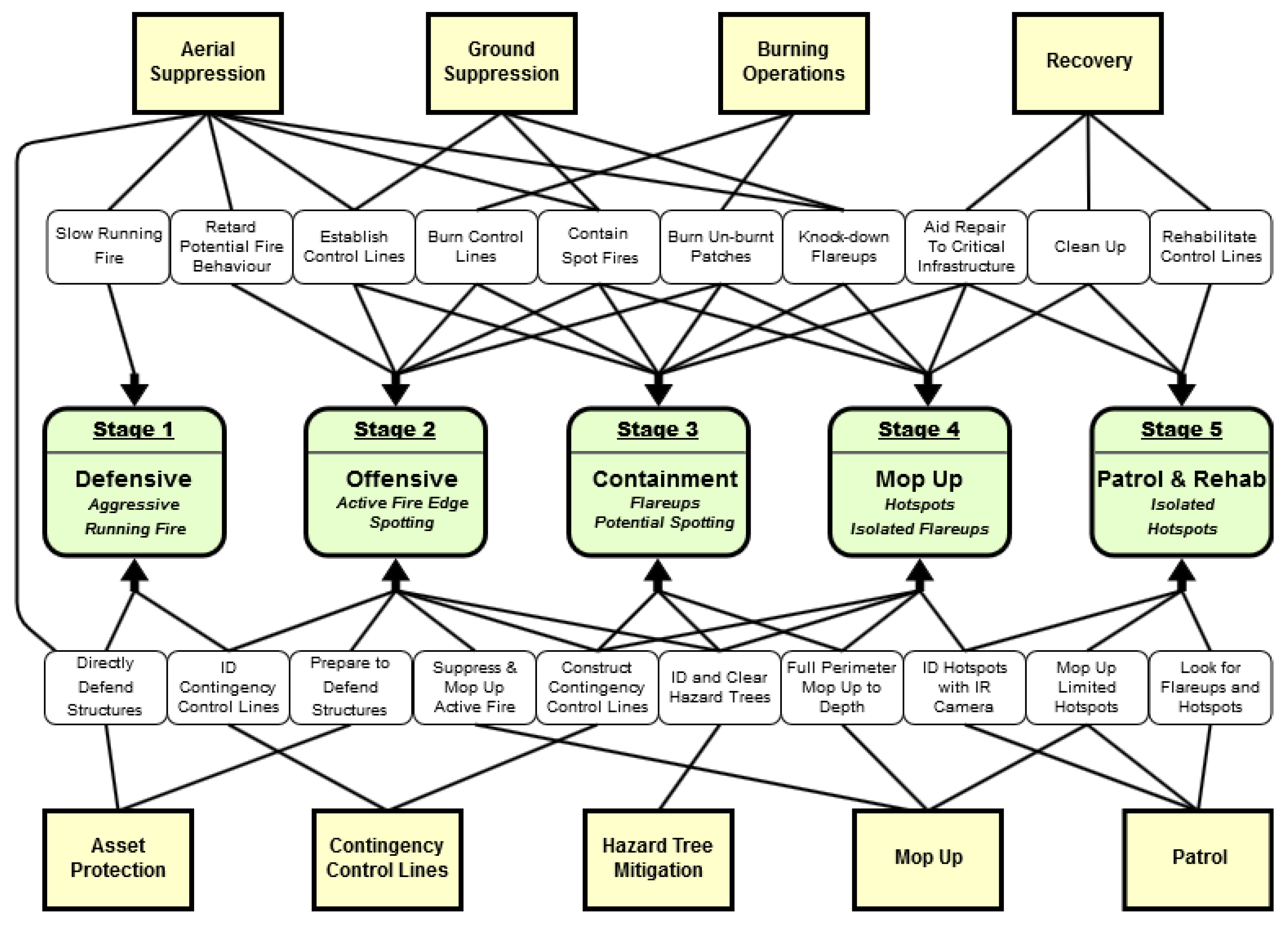
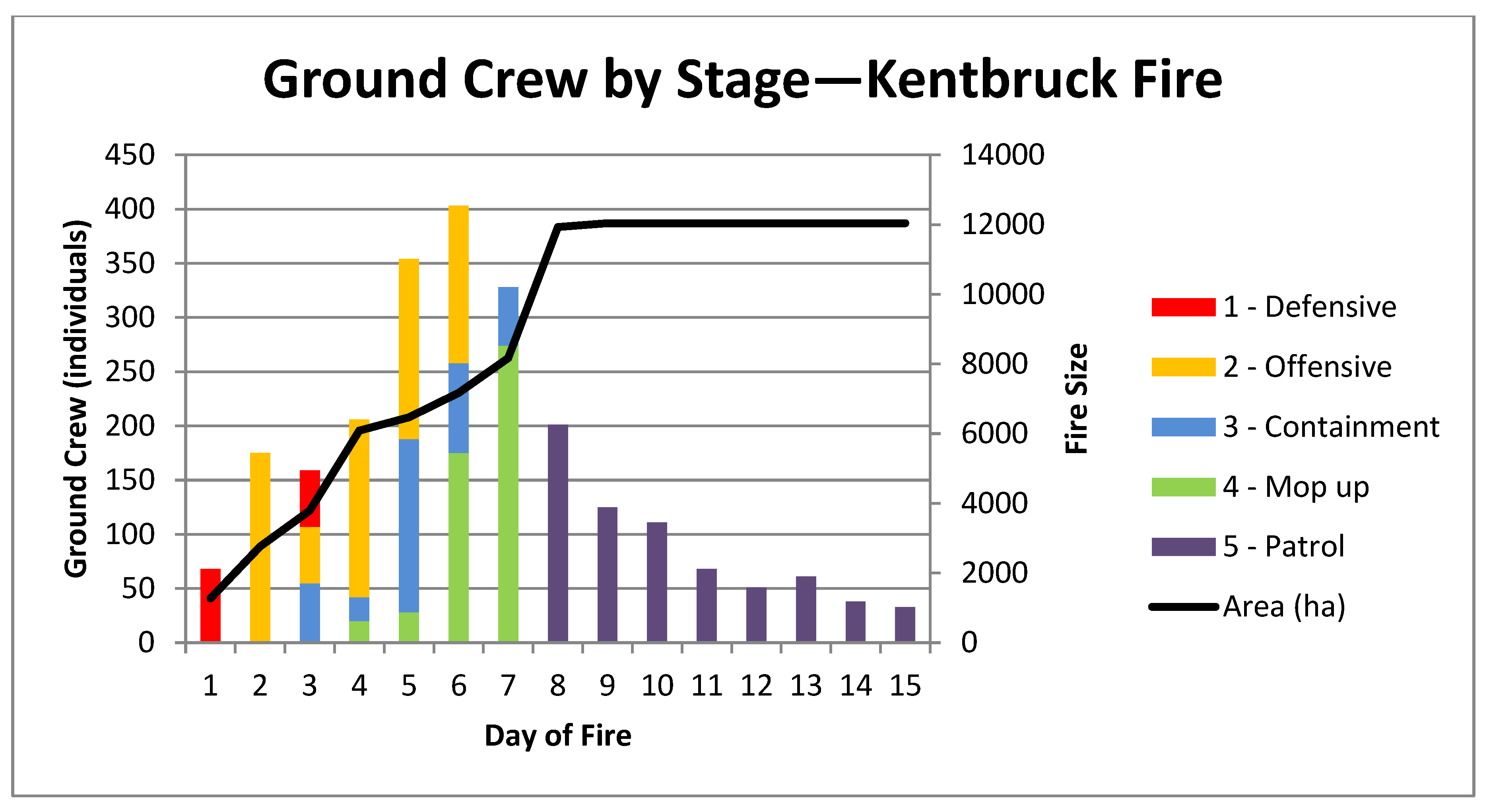
| Agency | Status | ||||
|---|---|---|---|---|---|
| This Study | 1—Defensive | 2—Offensive | 3—Containment | 4—Mop-Up | 5—Patrol and Rehab |
| DELWP 1 | Going | Contained | Under Control 1 | Under Control 2 | |
| NSW RFS 2 | Out of Control | Being Controlled | Under Control | ||
| QLD RFS 3 | Going | Contained | Patrol | ||
| NSW Parks 4 | Going | Being Contained | Contained | Patrol | |
| CIFFC 5 | Out of Control | Being Held | Under Control | ||
| Fire Name | Size (ha) | #SitReps | #Day IAP | #Night IAP | Total Documents | Days to Containment * | Primary Fuel Type |
|---|---|---|---|---|---|---|---|
| Stonyford | 593 | 16 | 4 | 3 | 23 | 1 | Grassland |
| Hallston | 629 | 57 | 16 | 3 | 76 | 4 | Native eucalypt forest |
| Powelltown | 674 | 34 | 8 | 5 | 47 | 17 | Native eucalypt forest |
| Corryong | 2617 | 53 | 14 | 9 | 76 | 11 | Native eucalypt forest |
| Morwell | 2945 | 31 | 14 | 6 | 51 | 6 | Scrub, grassland |
| Timbarra | 3096 | 53 | 27 | 12 | 92 | 25 | Native eucalypt forest |
| Lake Rowan | 5710 | 18 | 5 | 3 | 26 | 3 | Grassland |
| Kentbruck | 12,006 | 95 | 7 | 8 | 110 | 7 | Pinus plantation, heath |
| Mickleham | 22,832 | 27 | 5 | 4 | 36 | 5 | Grassland |
| Grampians | 54,616 | 95 | 27 | 11 | 140 | 6 | Native forest |
| Activity | Excerpt from SitRep or IAP | Source Fire |
|---|---|---|
| Unsuccessful | “The fire is burning in a South Westerly direction and has spotted over a ridge at XE 240064.4 helitak are working (including the Air Crane) on the running edge but having a limited influence at this stage [44] (p. 2).” | Grampians |
| Unattempted | “Fire is in very steep, remote and inaccessible country. Nearest vehicle tracks not suitable for float of machinery. Direct attack with hand crews not possible with current FDI/fire behaviour [45] (p. 2).” | Timbarra |
| Defensive Suppression | “Crews focusing on asset protection with the assistance of air support. Air support being used to slow the spread of head fire and spread of eastern flank [46] (p. 2).” | Mickleham |
| Activity | Excerpt from SitRep or IAP | Source Fire |
|---|---|---|
| Retard Fire Behaviour | “Significant air-attack support is available today to prevent the fire developing a head [49] (p. 2).” | Kentbruck |
| Contain Spot Fires | “There have been spotovers during the day which have been addressed utilising aircraft and direct attack [50] (p. 2).” | Lake Rowan |
| Mop Up and Control Lines | “Crews to continue to black out hotspots in forest and running edge in the grass lands, Plant being used to cut breaks in grasslands [51] (p. 2).” | Morwell |
| Contingency Lines | “Prepare fallback lines as identified on operations overview map. Pheasent Creek Tk-Commins D6 (Swifts Ck) working days brushing up from Buenba Rd. Dart Tk-Potocnik D6 and McInnes Exc & float [52] (p. 9).” | Corryong |
| Burning | “Burning off along Mt Difficult Rd has reached Mt Victory Rd (8 km ignited). Burning out has also commenced along the Mt Zero Rd, north of Heatherlie (0.5 km ignited). Burning out will continue throughout today and tonight [53] (p. 2).” | Grampians |
| ID and Clear Hazard Trees | “Excavator to work on hazardous trees on Donavan Creek Sector Priority 1: EV685449 to EV689443 Priority 2: EV687438 to EV697433 [52] (p. 9).” | Corryong |
| Prepare to Defend Structures | “To patrol area and undertake asset protection when required across the Drik Drik Division and Dartmoor area. Intelligence gathering and familiarisation of assets and access in area between Wanwin Rd and Munbannar-Wanwin Rd. [54] (p. 9).” | Kentbruck |
| Fire Behaviour | Excerpt from SitRep or IAP | Source Fire |
| Limited | “Fire Activity quiet over all sectors, very quiet over northern parts due to rain [55] (pp. 1–2).” | Timbarra |
| Moderate | “Crew walked into fire, active edge on fire—burning in rocky terrain in areas with no rocks flame heights are approximately 1 m [56] (p. 2).” | Timbarra |
| Aggressive | “The 3 smaller spot overs on the on the eastern side are contained using Dozer, hand crews and water bombing. The larger breakout on the eastern side is still not contained. Fire on the western side continued to run today towards 2013 fuel reduction burn. Was slowed by aerial retardant drops [57] (p. 1).” | Timbarra |
| Activity | Excerpt from SitRep or IAP | Source Fire |
|---|---|---|
| Control Line Progress | “2 sections of approx. 1 km each are untracked in forested areas. 2nd Dozer Is on-route to assist with this [58] (p. 2).” | Morwell |
| Control Line Completion | “Control lines established today with dozer in Boweya Forest Block and Orchard Tk sections and held throughout day [59] (p. 2).” | Lake Rowan |
| Burning Progress | “Kings Creek Tk Sector back burn has continued and progressed well overnight. 250 m of edge remains to the Gibbo River (Benambra Corryong Rd) at 0545 this may be completed by shift changeover [60] (p. 2).” | Corryong |
| “Crews have started to burn the last 150 m of unburnt edge, reports from yesterday’s burn are that it has gone in approx. 200 m [61] (p. 1).” | Timbarra | |
| Control Line vs. Burning Operations | “Dozer line complete on Southern sector between Scoullers Road and Ansons Road at 22:30. Fire is completely tracked. […] Burning out commenced between dozer line and fire edge near Scoullers Road [62] (p. 2).” | Stonyford |
| Interior vs. Perimeter Burning | “Strengthening of edges has been successful during the day. Combination of ADT and hand lighting has increased depth to 100 m plus in most sectors within the Cobboboonee Division. Burning out within fire area will continue for several days [63] (p. 2).” | Kentbruck |
| Activity | Excerpt from SitRep or IAP | Source Fire |
|---|---|---|
| Mop-up Depth | “Patrol and blackout to a good 30 m depth on all control lines [64] (p. 3).” | Powelltown |
| “Patrol and black to a depth of 60 m. (Forcast extreme conditions next Tuesday) [65] (p. 8).” | Grampians | |
| Burning | “Burn out unburnt fuel north of Hurdle Flat Rd between Glenelg National Park and the Kentbruck forest to ensure no break out to the south when fire comes under the influence of northerly winds on Thursday or Friday [66] (p. 5).” | Kentbruck |
| Rehabilitation | “Prepare and implement rehabilitation plans for all Sectors [67] (p. 6).” | Mickleham |
| Clean-Up | “Remove debris from private property (north of Forresters Rd) [68] (p. 5).” | Hallston |
| Hazard Trees | “Excavator on line to assist in tree removal to allow roads to be opened [69] (p. 2).” | Morwell |
| “A limitation in the number of skilled tree assessors and fallers is slowing the opening of some roads [70] (p. 2).” | Grampians | |
| Limited Hotspots | “Crew attended to one flare up this morning and was able to contain internal fire spread. FLIR is arranged for this morning to identify any additional hotspots [71] (p. 2).” | Mickleham |
| Activity | Excerpt from SitRep or IAP | Source Fire |
|---|---|---|
| Patrol | “Only a minor number of hotspots found well within containment lines. All edges secured. CONTROL STRATEGY Patrol [72] (p. 2).” | Lake Rowan |
| FLIR Identified Hotspots | “FLIR run undertaken yesterday. Crews deployed to black out hot spots. FLIR run arranged for Monday. Air recon this morning over the fire picked up only a few smokers [73] (p. 2).” | Morwell |
| Rehabilitation | “Old fence line clearing almost complete. 50% of fencing repairs complete. 10% of fencing replacement complete. Rehabilitation of control lines underway [74] (p. 2).” | Hallston |
| Demobilisation | “Significant progress has been made in the last few days. The complete perimeter of the fire is secured, no breakaway is expected. Formal transfer of control to CFA District 6 will take place at 1900 hrs. IMT will stand down at 1930 hrs after debrief [75] (p. 2).” | Stonyford |
| Fire Behaviour | Excerpt from SitRep or IAP | Source Fire |
| Characteristic Fire Behaviour | “Mild, stable conditions continue today. No active fire reported, some hotspots still visible [76] (p. 2).” | Hallston |
| Specific Area of Concern | “At 0354 h a hotspot was discovered at Grid Reference 288,177 in the East Sector which has been identified as requiring suppression efforts from a Tanker during the oncoming dayshift [77] (p. 2).” | Grampians |
| Internal Fire Behaviour | “Strong westerly winds (50–65 km/h) are reigniting hot spots within the fire perimeter. Continue black out and patrolling of eastern flanks of the fire. Some running edge within fire perimeter, burning unburnt fuel well within fire boundary [78] (pp. 1–2).” | Lake Rowan |
© 2019 by the authors. Licensee MDPI, Basel, Switzerland. This article is an open access article distributed under the terms and conditions of the Creative Commons Attribution (CC BY) license (http://creativecommons.org/licenses/by/4.0/).
Share and Cite
Simpson, H.; Bradstock, R.; Price, O. A Temporal Framework of Large Wildfire Suppression in Practice, a Qualitative Descriptive Study. Forests 2019, 10, 884. https://doi.org/10.3390/f10100884
Simpson H, Bradstock R, Price O. A Temporal Framework of Large Wildfire Suppression in Practice, a Qualitative Descriptive Study. Forests. 2019; 10(10):884. https://doi.org/10.3390/f10100884
Chicago/Turabian StyleSimpson, Heather, Ross Bradstock, and Owen Price. 2019. "A Temporal Framework of Large Wildfire Suppression in Practice, a Qualitative Descriptive Study" Forests 10, no. 10: 884. https://doi.org/10.3390/f10100884
APA StyleSimpson, H., Bradstock, R., & Price, O. (2019). A Temporal Framework of Large Wildfire Suppression in Practice, a Qualitative Descriptive Study. Forests, 10(10), 884. https://doi.org/10.3390/f10100884





